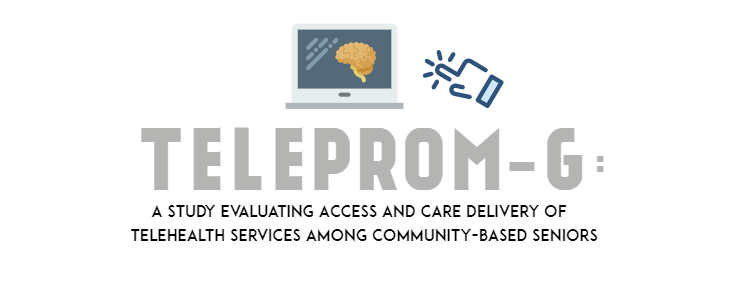Background
Mental illness is strongly associated with poor health outcomes in the older adult population — particularly depression, which stands out as a pervasive and complex issue. Recent literature suggests healthcare support delivered via mobile technology is well-suited to meet the complex needs of older adults in the community. However, there is a need for more substantive research addressing the implementation of technology in the older adult population.
Purpose and Overview of the Pilot Study
TELEPROM-G is a mobile-based Telemedicine and Patient-Reported Outcome Measurement platform designed to enhance delivery of health services among community-based older adults.
The primary objectives of this pilot study included:
- to examine the feasibility of implementing an electronic patient record (the Client Health Record or CHR) in the older adult population; and
- to determine if further modifications to the CHR or its features are necessary.
The project developed and tested a digital system for treating approximately 30 adults (aged 65 or older) with depressive symptoms living in the community. Depressive symptoms were measured using the short version of the Geriatric Depression Scale. Those with significant cognitive deficits (as determined by a Mini Mental State Examination) were excluded from participating.
This one year pilot project (April 2016 to April 2017) was funded by the Canadian Frailty Network, which is supported by the Government of Canada through the Networks of Centres of Excellence program.

Methods
Clients received tablet devices equipped with an eHealth mobile software platform: InputHealth’s Collaborative Health Record (CHR). This record has the ability to track patient-reported health outcomes and facilitate clinical evaluation. For the pilot study, the existing CHR platform was modified to include built-in video-conferencing capability which allowed clients to interact with their health care providers, from the comfort of their own home and in real-time. Clients were also able to schedule an appointment with their HCP and receive prompts form the system for self-care activities such as medication administration and personal coping strategies. Questionnaires (labelled as Qnaires on the electronic CHR) were sent to clients by HCPs.
Eight multidisciplinary mental-health care providers agreed to participate and identified clients from their caseloads, living in the community, who also consented to be participate in the study. HCPs receiveded training in the use of this technology to clinically assess clients by monitoring the CHR. HCPs monitored changes in health and functional well-being overtime and received alerts when changes exceed pre-set thresholds, which allowed for early interventions. The built-in video conferencing functionality allowed for real-time clinical interactions in the client’s home.
The research team used a mixed-methods (quantitative and qualitative) design to assess the feasibility of implementing the CHR in the older adult population. Individual interviews and focus groups were conducted with clients and HCPs to evaluate how TELEPROM-G potentially enhanced their work with clients.The research team supported participants throughout this study to ensure that the technology safely and effectively met the health care needs of both clients and staff.
The research team is involved in supporting participants throughout this study to ensure that the technology safely and effectively meets the health care needs of both clients and staff.
Evaluation
Four types of analyses were used to evaluate this technology:
- Effectiveness
- Economic
- Policy
- Ethics
Findings (As Reported by Clients)
- improved communication with their HCPs through the CHR and virtual visits
- ease of using the technology for the CHR
- convenience of using the tablet's applications for other purposes
- preference for using their own (familiar) computer
- not enough materials sent by HCPs to feel comfortable with the technology
Findings (As Reported by HCPs)
- greater awareness of clients' current mental health status and improved communication with clients through the CHR and virtual visits.
- concerns with organizational and time constraints
- challenges with their own use of technology
Conclusions
This pilot study highlighted potential benefits and constraints of implementing a collaborative health record model in seniors with symptoms of depression. Clients and HCPs expressed a desire to increase communications even further. The research team was successful in recruiting 30 clients, retaining 26, deploying the intervention and following for 6 months, which demonstrates the feasibility of a larger study. Valuable insight has been gained on how to modify the technology and facilitate deployment for a larger study including the need for enhanced communication functions, more technical support, and more in-depth training. Preliminary findings support the use of technology in helping seniors with depression connect with their health care providers. The study demonstrated that the use of eHealth technology may lead to increased communication between clients and HCPs by allowing them to stay connected in between scheduled vists. This may have implications in future redesigns of models of health care delivery. Information from this study was useful in enhancing the technology further prior to larger cohort studies across multiple sites.Principal Investigator
Cheryl Forchuk, RN, PhD
The Beryl and Richard Ivey Research Chair in Aging, Mental Health, Rehabilitation and Recovery, Parkwood Institute Research;
Distinguished University Professor, Arthur Labatt School of Nursing, Faculty of Health Sciences, Western University;
Assistant Director and Scientist, Lawson Health Research Institute
Mental Health Nursing Research Alliance
Lawson Health Research Institute
Parkwood Institute – Main Building
550 Wellington Road, B3-110C
P.O. Box 5777, STN B
N6A 4V2
Tel: (519) 685-8500, ext. 77034
Email: cforchuk@uwo.ca
